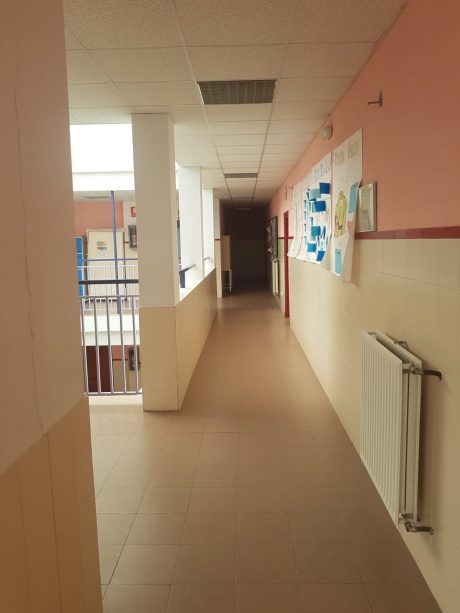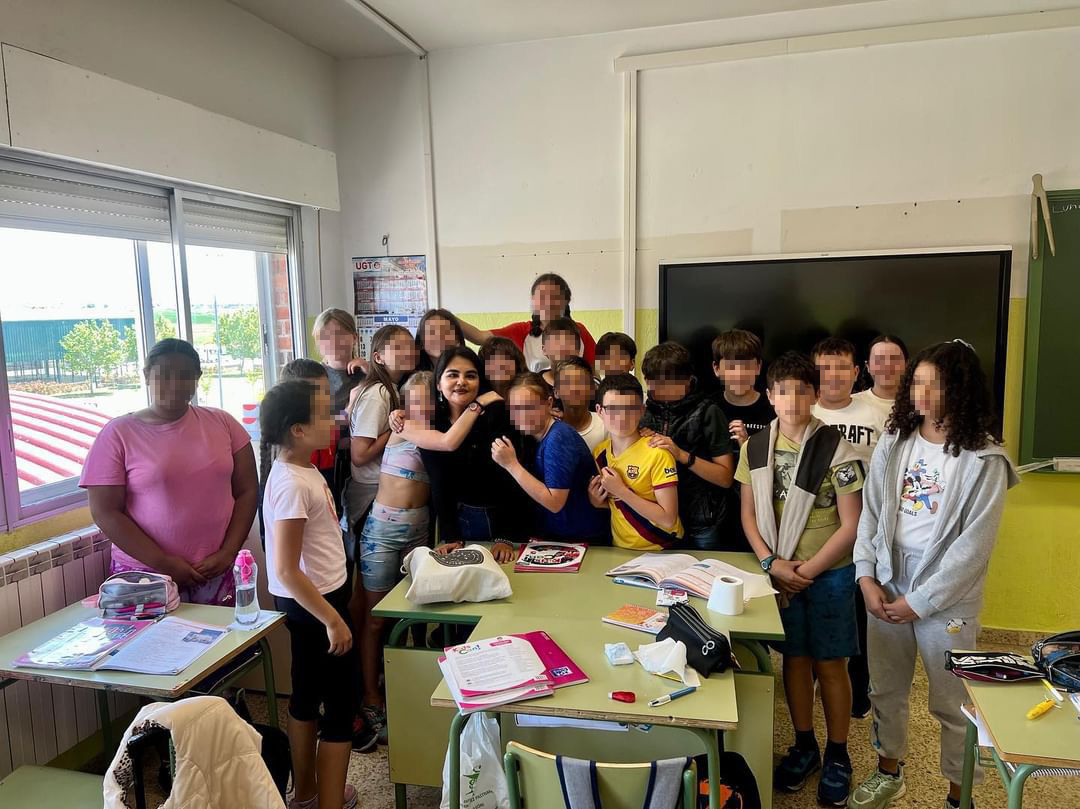By Andrea P., Auxiliar de Conversación in Madrid 18/19.
Even if you have taught before, every country has its own rules and expectations and Spain is no different. You will be happy to learn though that as the lifestyle, the teaching conditions here are laid-back. The Spanish teachers and students are friendly and welcoming, and you are likely to enjoy working with both of them. Before you make the leap into teaching English in Spain, it’s helpful to know just what you are getting yourself into!
1- Your Duties as a Language Assistant May Vary
Browsing the many posts in the various unofficial auxiliar Facebook pages, you will see that there are countless questions regarding our actual duties. I find even different duties in my own school.
I do many different things depending on the teacher I am teaching with. In a couple of classes, the main teacher and I teach completely collaboratively. These are the lessons I like the most. Overall, I tend to take small groups out of the room during most classes, which gives me some freedom to throw in my own activities, but also can be stressful when asked to do things last minute.
If you feel you are being asked to do things outside of your scope as an assistant, don’t be afraid to (respectfully) speak up. One thing is clear though: we are not responsible for grading, creating or carrying out exams, or discipline in any form. We should not be leading entire classes alone without the presence of a licensed teacher either.
2- Certain Grammar Points are Notoriously Tricky for Spanish-speakers
When teaching with Spanish-speakers, you’ll start to notice the same mistakes being made by nearly all of your students. A lot of these have to do with two things: lack of an equivalent word in Spanish and direct translation.
When English words don’t exist in Spanish, it can be hard for the students to wrap their head around correct usage. For example, the article ‘it’ doesn’t exist in Spanish. Because of that, my students will completely omit it when speaking or writing. Another example is English’s use of both do and make, where Spanish has one word: hacer. You will hear students saying, “do the bed” or “make their homework.” It can be confusing for them to know when to use which verb.
Direct translation is a problem for speakers of all languages when learning a new one. I am guilty of the same in Spanish. Of course, it’s logical to think that if you don’t know the native phrase, you will directly translate it. That’s why assistants are here, to correct these mistakes. However, a lot of mistakes have become deeply ingrained and thus hard habits to break. For all of these issues, consistency in correction is key.
3- In Primary School, You’ll Get a Long Lunch – Two Hours to Be Exact
If you find yourself placed in a primary school, be sure to have something to do during long lunch breaks. As opposed to secondary school, which only has a 30-minute break, you’ll have two hours at your disposal in primary. The first time I taught as an assistant, I was in a primary school and spent my lunches eating, reading, planning for classes, taking walks, or chatting with the teachers. I lived close enough to the school that, some days, I even walked home to eat and take a siesta. You can view those two hours as a blessing or a curse. Although I enjoyed the free time during the day, I didn’t really like getting out at 5pm while friends in secondary were finished at 2:25pm. Like everything, the time will be what you make of it!
4- If you want to live in a city, be ready for the possibility of a long commute

5- The Students are Mad for Sport
Even if they don’t play sports, most students are big fans. Just ask a classroom if they support Real Madrid or Atlético and watch the place erupt into madness. Soccer, or football as it is called in Spain, is a way of life and the kids will have a particular interest in it. If you don’t want to focus on sports for your lessons, one common thread will always keep the students engaged: competition. Turn anything into a game with two or more teams and you will have their undivided attention. Most of the time though, using competition-based activities are a good way to keep the students interested and having fun.
6- Fun, Interactive, and Dynamic Lessons are Appreciated by the Students
Teachers rely heavily on books here. When you’re not assisting in class, the students are likely working directly out of the book doing readings and exercises. The teachers have a curriculum to follow, but the books can be very dry and doing mainly reading and writing limits speaking opportunities. It can be tempting to hand out worksheets to your students because it’s easier to control them when they’re doing individual work. However, as native speakers, our most important role is to engage the kids verbally and work on usage and pronunciation. If you do use worksheets to reinforce a point or test understanding, be sure to go over it with them after they are finished. I try to use at least one game during my lessons. If they don’t get too rowdy, I try to get them out of their seats as well. Students will remember content from fun and creative lessons.
7- Spanish Kids are Boisterous
You’ll find that Spanish children like to talk. Most of the time, they’re talking when you don’t want them to. The system of discipline in Spanish schools is much different than that of the US and this can be very frustrating. I battle with feeling disrespected when my students won’t listen to me. In the end, all we can do is the best we can and leave the discipline up to the main teachers. Overall, the students are very nice kids. They’re good-natured, funny, and enthusiastic. It’s easy to compare the behaviour to your own experiences in the US school system and find it shocking. But, once you start to understand the differences, you’ll find your own ways of working with them.
8- In Secondary School, the Kids Have a Lot of Exams and Projects
My school runs on trimesters and every term there is a heap of exams and projects whose due dates all fall within a one- or two-week period. It is common for your students to have five or six exams in one week, three times during the school year. During these times, they will be extra stressed out. I try to incorporate games into small group time to lessen the burden. The assistant’s schedule will likely be a bit out of whack, too, so flexibility is key. You may be shuffled around to other classes if you are not needed by your main teachers.
9- Schools Will Have Different Levels of Technology Available
I teach in a village school and some days the internet connection is nonexistent. Some days, I’ll need a room with a projector for my small group classes, but one may not be available. Depending on where you are placed, you may have the latest smart boards and high-speed internet or you may have just a good old-fashioned chalkboard. Be prepared to find solutions such as working with printed handouts or making your own visuals if you find yourself in the latter. It may seem inconvenient at first, but once you get the hang out it, you’ll find you are actually quite creative.
10-Try to be as Collaborative as Possible
Language Assistants come and go and the teachers know this. Some may have had less than stellar assistants in the past and are understandably wary. From day one, try to be as cooperative and collaborative as you can with the teachers you collaborate with. We may just be Auxiliares de Conversación, but we shouldn’t have a passive attitude about our role in the classroom. Establish expectations from the get-go so you can work to meet them. This will help you to avoid any misunderstandings and will make the year a lot more organized and smooth. Five years ago, I collaborated with two teachers. This year, I teach with eight. It takes some juggling to check in with them all (WhatsApp makes this much easier!), but it’s necessary to be sure I have everything covered.
Teaching in Spain is all about embracing change and approaching every new situation with an open mind. While things may be different than what you’re used to, it doesn’t mean they’re wrong. Coming into the school year with a positive attitude and loads of flexibility will get you far and ensure you have the best experience of your life!










One Response
I really enjoyed reading 10 things to know about teaching English in Spain. I am more interested in an opportunity after reading as this piece gives you insight as to what can be expected in the simplest way. Thanks